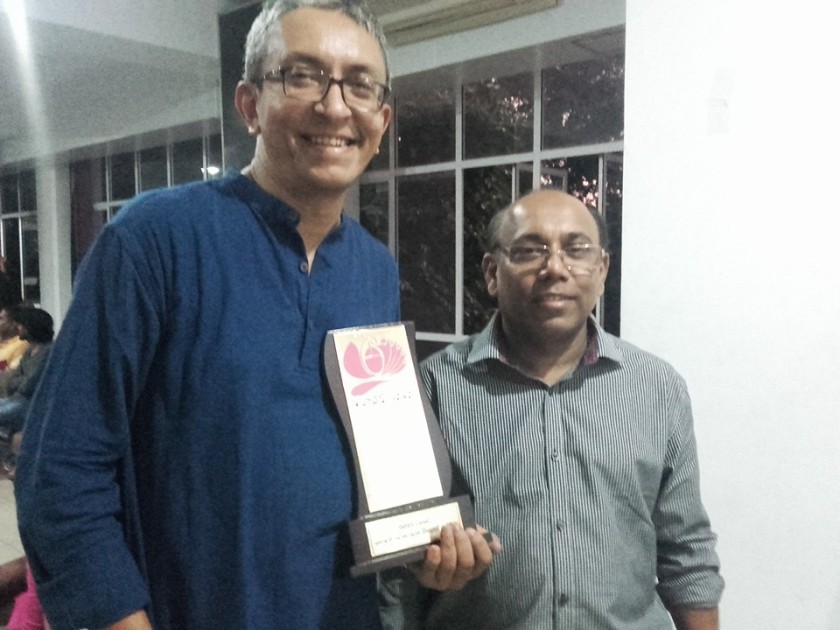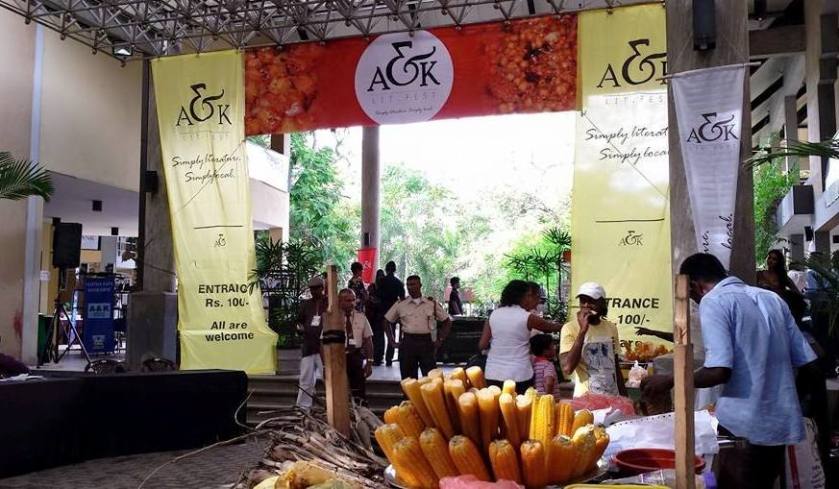Some say that blogging is in decline and claim that the days are numbered for this art of web-based writing and sharing of all kinds of content. But not (yet?) in Sri Lanka’s local languages of Sinhala and Tamil, where vibrant blogospheres exist, sustaining their own subcultures and dynamics.
In this article (in Sinhala) written in April 2017 and published in Desathiya magazine of November 2017, I I look around the Sinhala language blogosphere in Sri Lanka, and offer a few glimpses on how the myriad conversations are unfolding. In that process, I also try to demystify blogs — about which popular myths and misconceptions persist in Lankan society (some of them peddled by the mainstream media or uninformed mass media academics).

නෙළුම්යාය සහෘද සමූහය සංවිධානය කළ හොඳම බ්ලොග් සඳහා සම්මාන පිරිනැමීමේ උළෙල තෙවන වරටත් 2017 මාර්තු 25 කොළඹදී පැවැත්වුණා. එහිදී මෙරට බ්ලොග් අවකාශය, පුරවැසි මාධ්යකරණය හා ඒ හරහා මතු වන අවස්ථා හා අභියෝග ගැන කතා කිරීමට මට ඇරැයුම් කොට තිබුණා.
2017 ඇරඹෙන විට මෙරට ජනගහනයෙන් 30%ක් පමණ දෙනා නිතිපතා ඉන්ටර්නෙට් භාවිත කළ බව රාජ්ය දත්ත තහවුරු කළා. එහෙත් එහි බලපෑම ඉන් ඔබ්බට විශාල ජන පිරිසකට විහිදෙනවා. වෙබ්ගත වන ගුරුවරුන්, මාධ්යවේදීන් හා සමාජ ක්රියාකාරිකයින් ලබන තොරතුරු ඔවුන් හරහා විශාල පිරිසකට සමාජගත වන නිසා.
මේ නිසා වෙබ් අවකාශයේ එක් සුවිශේෂී අන්තර්ගතයන් කොටසක් වන බ්ලොග් ගැන ටිකක් විමසා බැලීමට මෙය හොඳ අවස්ථාවක්.
බ්ලොග් යනු තම අදහස් හා මතවාදයන් සෘජුවම වෙබ්ගත කිරීමයි. බ්ලොග් (blog) ඉංග්රීසි වදන සෑදී තිබෙන්නේ වෙබ් ලොග් (web log) යන වදන් දෙක එකතු වීමෙන්. සරල අරුත නම් වෙබ් අවකාශයේ ලියන සටහන් යන්නයි. මේ වචනය බිහි වුණේ 1997දී වුවත් බ්ලොග් ලෙස සැලකිය හැකි වෙබ් ලියවිලි 1994 පටන් පැවතුණා.
බ්ලොග්වලට වචන, රූප, වීඩියෝ හෝ හඬ හෝ මේවායේ මිශ්රනයක් යොදා ගත හැකියි. එහි සුවිශේෂත්වය එය කියැවීමෙන් පසු අදහසක් එක් කිරීමේ (කමෙන්ටුවක් දැමීමේ) හැකියාව ඕනැම වෙබ් පාඨකයකුට තිබීමයි. අන්තර්ක්රියාකාරී බවයි.
බ්ලොග් ලේඛනය පුරවැසි මාධ්යකරණයේ (Citizen Journalism) එක් පැතිකඩක්. පුරවැසි මාධ්යකරණය ගැන විවිධ අර්ථ දැක්වීම් හා විග්රහයන් තිබෙනවා. සරලතම විදියට කිවහොත් මාධ්ය ආයතනගතව, වැටුප් ලබමින් මාධ්යකරණයේ නියැලෙනවා වෙනුවට එම කාරිය ම නොමිලයේ, පොදු අවකාශයේ උද්යෝගයෙන් කරන අය පුරවැසි මාධ්යවේදීන්.
අපේ උරුමයේ කොටසක්

නව සන්නිවේදන තාක්ෂණ මෙවලම් ප්රචලිත හා ලාබදායක වීම නිසා රටේ හා ලෝකයේ තමන් අවට සිදු වන දේ ලිඛිතව හා රූප හරහා හසු කර ගනිමින් ‘සාක්ෂි දැරීමේ’ (bearing witness) හැකියාව අද බොහෝ දෙනකුට ලැබී තිබෙනවා. කැමරාවක් සහිත ජංගම දුරකථනයක් (smartphone) මෙයට සෑහෙනවා.
මේ හැකියාව ලැබී තවමත් දශක දෙකක්වත් ගත වී නැහැ. ඓතිහාසිකව මෙසේ සාක්ෂි දැරීමේ හා වාර්තා කිරීමේ හැකියාව තිබුණේ ආයතනගත මාධ්යවේදීන්ට පමණයි. ඒ සීමිත බලය හරහා ඔවුන්ට යම් ප්රතාපවත් බවක් හා අධිපති බවක් ද ආරෝපණය වූවා.
පුරවැසි මාධ්යකරුවන්ගේ ආගමනය හරහා ඒ යථාර්ථය උඩුකුරු වනවා. අධිපති මාධ්යවේදයේ සමහරුන් තමන්ගේ සමාජ තත්ත්වය දියාරු වීම හා නැතිවීම ගැන කැමැති නැහැ. ඔවුන් බ්ලොග් රචකයන් හෙළා දකින්නේ එනිසායි.
පුරවැසි මාධ්යකරණයේ එක් මූලික ලක්ෂණයක් වන්නේ කිසිදු අවසරයක්, පාලනයක් නැතිව කෙලින් ම අදහස් දැක්වීම. අප අද කාලේ එය ඉන්ටර්නෙට් හරහා කරන සන්නිවේදනයක් ලෙස හඳුනා ගත්ත ද එයට සංකල්පමය වශයෙන් දිගු ඉතිහාසයක් තිබෙනවා.
සීගිරියේ කැටපත් පවුරේ කුරුටු ගී/ලිපි ලිව්වේ අවසර ලබා ගෙන නොවෙයි. සීගිරි බිතු සිතුවම්වල සිටින අප්සරාවන් ගැන සියවස් ගණනක් පුරා එහි ගිය ඇතැම් දෙනා තමන්ගේ අදහස් හා හැගීම් එහි ලියා තිබෙනවා. සීගිරි කුරුටු ගී/ලිපි ලියූ හැම අයකු ම මීට සියවස් ගණනකට පෙර මෙරට විසූ පුරවැසි මාධ්යවේදීන්!
කාශ්යප රජු විසින් සීගිරිය රාජධානිය කර ගනු ලැබුවේ ක්රිස්තු වර්ෂ 5 වන සියවසේදී. දැනට දන්නා පැරණි ම සීගිරි කුරුටු ගී 6 හා 7 වන සියවස්වලට අයත්. බහුතරයක් කුරුටු ගී 8, 9 හා 10 වන සියවස්වල ලියා ඇතැයි ද සුඵ සංඛ්යාවක් 11 සිට 13 වන සියවස් අතර කාලයේ ලියැවී ඇතැයි ද පුරා විද්යාඥයන් කියනවා.
සීගිරි කුරුටු ගී අසාමාන්යයි. කිසිවකුගේ අවසරයක්, අධීක්ෂණයක් හෝ අනුදැනුමක් නැතිව නිදහසේ අදහස් පළකොට තිබෙනවා. ඒ සඳහා ලියූ අයගේ තරාතිරම, උගත්කම බලපා නැහැ. (අකුරු ලිවීමේ/කෙටීමේ හැකියාව සීමාකාරී සාධකය වූ බව සැබෑවක්.)
සීගිරි කුරුටු ගී/ලිපි ලියූ අපේ ආදිතමයෝ පුරෝගාමී පුරවැසි මාධ්යවේදීන් ලෙස සැළකිය හැකිදැයි සන්නිවේදන විශෙෂඥ මහාචාර්ය රොහාන් සමරජීවගෙන් මා විමසුවා. ඔහු එයට එකඟ වුණා. හේතුව ඔවුන්ට ඉහළින් තීරණ ගන්නා කිසිදු කතුවරයකු හෝ අවසර දෙන්නකු නොසිටි නිසා.

නූතන පුරවැසි මාධ්යකරුවෝ
අද අප දන්නා ආකාරයෙන් වෙබ් අවකාශය (World Wide Web) නිපදවනු ලැබුවේ 1989දී. 1990 දශකය තුළ එය සෙමින් ලෝකය පුරා ව්යාප්ත වුණා. මුල් යුගයේ වෙබ් අඩවියක් නිර්මාණය කරන්නට, සංශෝධනය හෝ යාවත්කාලීන කරන්නට පරිගණක ශිල්ප දැනුම ඉහළට දැන සිටීම ඕනෑ වුණා.
මේ තත්ත්වය වෙනස් වූයේ 1990 දශකය අගදී. බ්ලොග් ලිවීමට පරිගණක භාෂා දැනුම ඕනැ නැහැ. සාමාන්යයෙන් පරිගණකයක් හසුරුවන්නට හා යම් බසකින් ටයිප් කරන්නට දැන සිටීම ප්රමාණවත්. මේ සඳහා නොමිලේ වෙබ් ඉඩ ලබා දෙන සයිබර් වේදිකා බිහි වුණා (Blogger 1999; WordPress 2003).
අද බොහෝ පුවත්පත්වල අන්තර්ගතයට වඩා සාරගර්භ, සන්වාදශීලී අන්තර්ගතයන් බ්ලොග් අවකාශයේ හමු වන බව දිගු කාලීන නිරීක්ෂන මත මගේ වැටහීමයි.
බ්ලොග්කරණය හිතෙන හා ඉඩපාසු තිබෙන වෙලාවට ස්වේච්ඡාවෙන් කරන කාරියක්. එසේම බොහෝ විට බ්ලොග් රචකයන් ප්රසිද්ධිය සොයා නොයන, සමහරවිට ආරූඪ නම්වලින් ලියන අය නිසා මේ ක්ෂේත්රයේ කවුරුන් කුමක් කෙසේ කරනවාද යන්න හරිහැටි තක්සේරු කිරීම ලෙහෙසි නැහැ.
ශ්රී ලංකාවේ මේ වන විට බ්ලොග් ලේඛකයන් කීදෙනකු සිටිනවාද යන්න හරිහැටි පැහැදිලි නැහැ. නෙළුම්යාය සංවිධායකයන්ගේ අනුමානය නිතිපතා සක්රිය සිංහල බ්ලොග් රචකයන් 400ක් පමණ සිටින බවයි. මගේ වැටහීමට අනුව නම් මෙරට භාවිත වන තිබසින් එකක් යොදා ගනිමින් බ්ලොග් පවත්වාගෙන යන දහසකට වැඩි දෙනකු සිටින බවයි.
මේ සමහරුන් සංඛ්යාත්මකව කුඩා පාඨක පිරිසක් ආකර්ෂණය කර ගන්නා අතර කැපී පෙනෙන බ්ලොග් අඩවිවලට දිනකට දහස් ගණනක් පාඨකයන් පැමිණෙනවා. අඩුවෙන් විකිණෙන දිනපතා පත්තරවලට වඩා පාඨක පිරිසක් නිතිපතා කියවන ජනප්රිය බ්ලොග් ලේඛකයන් කීප දෙනකු දැන් සිටිනවා. එවැනි බ්ලොග් රචනා සමහරකට දුසිම් ගණන් ප්රතිචාර ලැබෙන අතර බොහෝ විට මුල් රචනයට වඩා දිගු පාඨක සංවාද හා විසංවාද දිග හැරෙනවා.
පුරවැසි මාධ්යවේදීන් ආධුනිකයන් ද? සමහර ආයතනගත මාධ්යවේදීන් තමන් වෘත්තිකයන් බවත්, එතැනට පැමිණීමට පුහුණුවක් හා අභ්යාසයක් කලක් ප්රගුණ කළ බවත් කියමින් පුරවැසි මාධ්යවේදීන් හෑල්ලූ කරන්නට තැත් කරනවා. එහෙත් අද වන විට මේ ආධුනික/වෘත්තික බෙදුම බොඳ වී ගිහින්.

බ්ලොග් අවකාශයේ විචිත්රත්වය
බ්ලොග් ලේඛකයන් විවිධ සමාජ, අධ්යාපනික හා වෘත්තීය පසුබිම්වලින් මතුවනවා. ඔවුන් අතර විවිධත්වය ඉහළයි. පාසල් හා සරසවි සිසුන්, ගුරුවරුන්, රාජ්ය පරිපාලන නිලධාරීන්, වෛද්යවරුන්, නීතිවේදීන් හා විශ්රාමිකන් ඒ අතර සිටිනවා. ඇතැම් වෘත්තීය මාධ්යවේදීන් ද තමන්ට නිල වශයෙන් කීමට නොහැකි දේ පවසන්නට බ්ලොග් කරනවා. මා 2007දී බ්ලොග් ලිවීම ඇරඹුවේ එම අරමුණින්.
බහුතරයක් අපේ බ්ලොග් ලේඛකයන් ලියන්නේ තම සැබෑ නමින්. එහෙත් ආරූඪ නමින් ලියන අයද සිටිනවා. එයට හේතු තිබෙනවා (උදා: රාජ්ය සේවකයන්ට හා තවත් සමහර වෘත්තිකයන්ට රැකියාවෙන් පනවා ඇති සීමා නිසා).
ආරූඪ නමින් ලිවීම ඕනැම ලේඛකයකුට ඇති අයිතියක්. මාර්ටින් වික්රමසිංහ හා ඩී බී ධනපාල වැනි දැවැන්තයොත් එසේ කර තිබෙනවා.
නමුත් වෙබ්ගතව අදහස් පළ කරන අයටද රටේ නීති අදාලයි. සාවද්ය හා ද්වේශසහගතව යමක් ලිව්වොත් අපහාස නීතිය යටතේ සිවිල් නඩුවක් පැවරිය හැකියි. ආරූඪනම්වලට මුවා වී අභූත චෝදනා හෝ බොරු පතුරවන්නට බැහැ.
බ්ලොග් අවකාශයේ ඉතා හරබර තොරතුරු හා සංවාද රැසක් නිරතුරුව දිග හැරෙනවා. කාලීන සමාජ, ආර්ථික හා දේශපාලනික මාතෘකා ගැන නව මානයන්ගෙන්, නිදහස් හා හරවත් අදහස් රැසක් පළ කැරෙනවා. එයට අමතරව ගද්ය හා පද්ය ක්ෂේත්ර දෙකෙහිම නව නිර්මාණ ලියැවෙනවා. බොහෝ බ්ලොග් වචනවලට සීමා වුවත් සමහරක් බ්ලොග්වල මුල තැන ලැබෙන්නේ ඡායාරූප, කාටූන්, මල්ටිමීඩියා (බහුමාධ්ය) නිර්මාණවලටයි.
බ්ලොග් ලේඛකයන් ලියන්නේ ආත්ම තෘප්තියට. එහෙත් ස්වේච්ඡාවෙන් බ්ලොග්කරණයේ නියැලෙන්නන් ගැන සමාජයේ ඇතැම් දුර්මත තිබෙනවා. රාජ්ය නොවන සංවිධානවලින් මුදල් ආධාර බලාපොරොත්තුවෙන් හෝ වාණිජ පරමාර්ථ ඉටු කර ගැනීමේ අරමුණින් යුතුව බ්ලොග්කරණයේ නියැලෙන බවට ඇතැම් පිරිස් විසින් චෝදනා නැගුව ද එම චෝදනාවලට කිසිදු පදනමක් නැහැ.
මෙවර නෙළුම්යාය සම්මාන දිනූ ලේඛකයන් පරාසය දෙස බැලූ විට බ්ලොග් අවකාශයේ විචිත්රත්වය පෙනනවා. හොඳම බ්ලොග් රචකයා සඳහා ප්රථම ස්ථානය දිනා ගත්තේ නිදහස් සිතුවිලි බ්ලොග් අඩවියේ රවී වීරසිංහ සහ රන්දිකා රණවීර ප්රනාන්දුයි. රැකියාවට විදෙස්ගතව සිටින රවි වැනි බ්ලොග් ලේඛකයන් රැසක් සිටිනවා.
දෙවන ස්ථානය දිනූ “සොඳුරු සිත” බ්ලොගය ලියන්නේ මාතර රජයේ පාසලක උද්යෝගිමත් විද්යා ගුරුවරියක් වන වත්සලා. පන්තිකාමරයේ, පාසලේ හා ගමේ සිදුවීම් සංවේදී හා චමත්කාර ලෙසින් හසු කර ගන්න ඇය සමත්.
තෙවන ස්ථානය දිනූ “ඉකොනොමැට්ටාගේ බොජුන්හල” බ්ලොගය ලියන ඉකොනොමැට්ටා, දත්ත හා කරුණු මනා ලෙස භාවිත කරමින් බොහෝ තත්කලීන දේ විග්රහ කරන්නෙක්. නව දැනුම උකහා ගෙන රසවත්ව බෙදා ගන්නෙක්.
හතරවන ස්ථානය දිනූ “Transylvania” ද්විභාෂික බ්ලොගය ලියන කැනඩාවේ නිවැසි වෛද්ය රුවන් එම්. ජයතුංග, මනෝචිකිත්සාව පිළිමඳ විශේෂඥයෙක්. මෙරට ප්රබන්ධ සාහිත්යයේ චරිත හා දේශපාලන චරිත මනෝවිශ්ලේෂන කෝණයෙන් විද්වත්ව විග්රහ කරන්නට සමතෙක්.
බ්ලොග් සම්මාන දිනූ ලේඛකයන් අතර උතුරේ රජයේ රෝහල්වල යුද්ධ කාලයේත් ඉන් පසුවත් සේවය කළ වෛද්ය බෝධිනී සමරතුංග ද වනවා. “අනිත් කොන” බ්ලොගය හරහා බෙදා ගැනෙන ඇගේ අත්දැකීම් අනුවේදනීයයි. ඇගේ දැක්ම මානව හිතවාදීයි.
2016 වසරේ හොඳම ඉංග්රීසි බ්ලොගය සඳහා සම්මාන දිනූ සුභා විජේසිරිවර්ධන, මෙරට සිටින ඉතා කුසලතා සම්පන්න තරුණ සමාජ ක්රියාකාරිනියක්. ස්ත්රී පුරුෂ සමාජභාවය ගැන අලුත් විදියට සිතන හා ලියන ලේඛිකාවක්.
නෙළුම්යාය (http://nelumyaya.com) සංස්කාරක හා ‘කොළඹ ගමයා’ නමින් බ්ලොග් ලියන අජිත් ධර්මකීර්ති කියන්නේ මෑත වසරවල සිංහල බ්ලොග් අවකාශය විවිධත්වයෙන් හා සහභාගිත්වයෙන් බෙහෙවින් පුළුල් වී ඇති බවයි. නව පන්නයේ නිර්මාණාත්මක සාහිත්යයක් දැන් බ්ලොග් හරහා මතු වී තිබෙනවා.
සම්මාන දුන් නිමිති දෙස බලන විටද මෙය පැහැදිලියි: අතීතකාම, ඉතිහාසය, කෙටිකථා, පරිවර්තන, ප්රහසන, නවකතා, විද්යා ප්රබන්ධ, විද්යා හා තාක්ෂණ, සංගීතය, සංචාරක හා ඡායාරූප, සාහිත්ය කලා විචාර ආදිය ඒ අතර වනවා. ඉස්සර පත්තරවලින් මතු වූ නවක ලේඛකයෝ දැන් බ්ලොග් අවකාශයෙන් මතු වනවා. මේ නව යථාර්තය වියපත් කතුවරුන් හෝ පණ්ඩිතයන් දකින්නේ නැහැ.

බ්ලොග් උපසංස්කෘතියක්
බොහෝ බ්ලොග් රචකයන් ප්රධාන ප්රවාහයේ මාධ්යවල පිළිගැනීම හෝ ආවරණය පතන්නේ ද නැහැ. බ්ලොග් යනු උප සංස්කෘතියක්. එයටම ආවේණික ජවයක් හා ගතිගණ සමුදායක් එහි තිබෙනවා. එහෙත් එන්න එන්නම රසබර හා හරබර අන්තර්ගතය වැඩියෙන් බිහි වන බ්ලොග් අවකාශය වැඩි ලාංකික පාඨක පිරිසක් වෙත ගෙන යා යුතු යැයි ධර්මකීර්ති මතු කරන තර්කයට මා එකඟයි.
බ්ලොග් අවකාශයට ඔබ මුල් වරට පිවිසෙන්නේ නම් එහි අගමුල හඳුනා ගැනීම තරමක අභියෝගයක්. හැම බ්ලොග් එකකම නිතිපතා අලූත් රචනයක් හෝ එකතු කිරීමක් සිදු වන්නේ නැහැ. අලුතින් බ්ලොග් රචනයක් හෙවත් පෝස්ටුවක් එකතු වූ බ්ලොග් ලැයිස්තු ගත කරමින් ගතික ලෙස නිරතුරු යාවත්කාලීන වන මාර්ගෝපදේශක වෙබ් අඩි තිබෙනවා. මේවාට බ්ලොග් කියවනයන් (blog syndicators, blog aggregators) යයි කියනවා.
ලාංකික බ්ලොග් කියවනයක් මුලින්ම බිහි වූයේ 2005 අප්රේල් මාසයේ. කොත්තු (www.kottu.org) නම් වන එහි ස්වයංක්රීයව අලුත්ම බ්ලොග් පෝස්ටුවල හෙඩිම හා මුල් වැකිය පෙන්වනවා. කැමැති අයට එතැනින් ක්ලික් කොට මුලු බ්ලොග් එකම කියැවීමට යා හැකියි. මීට අමතරව දැන් සතුටු වැස්ස, ලාංකීය සිතුවිලි, ටොප් සිංහල බ්ලොග් වැනි කියවනයන් කිහිපයක් තිබෙනවා. මේ එකක්වත් සියලු ලාංකික හෝ සිංහල බ්ලොග් ආවරණය නොකළත් අලුත් බ්ලොග් නිර්මාණ ගැන ඉක්මනින් දැන ගැනීමට මෙවැන්නකට පිවිසීම ප්රයෝජනවත්.
තනි පුද්ගලයන් පවත්වාගෙන යන බ්ලොග්වලට අමතරව සමූහයකගේ ලියවිලි හා වෙනත් නිර්මාණ පළකරන, බ්ලොග් ද තිබෙනවා. කලා-සංස්කෘතික හා දේශපාලනික ප්රශ්න විචාරයට ලක් කරන බූන්දි අඩවියත් (www.boondi.lk), කාලීන සමාජ හා දේශපාලන සංවාදයන්ට වේදිකාවක් සපයන විකල්ප අඩවියත් (www.vikalpa.org) කැපී පෙනෙන උදාහරණයි.
සිංහල බ්ලොග් අවකාශයේ ප්රබල භූමිකාවක් හිමි කර ගත්, W3Lanka නමින් ද්විභාෂික බ්ලොග් අඩවියක් කරන, අජිත් පැරකුම් ජයසිංහ කියන්නේ අපේ බ්ලොග්කරණය තවමත් මූලික අදියරයක පවතින බවයි. තව යා හැකි හා යා යුතු දුර බොහෝයි.

ලාංකික බ්ලොග් අවකාශය වසරක් පාසා පුළුල්වෙමින් ඇතත් බ්ලොග් ලේඛකයන්ට සමාජ පිළිගැනීමක් තවමත් බිහි වී නැහැ. ඔවුන්ට ‘බ්ලොග්කාරයෝ’ යැයි කීම හරහාම යම් අවතක්සේරුවක් සිදු වනවා. එකම ලිපිය පත්තරයක, සඟරාවක පළ වූ විට ලැබෙන සමාජ ප්රතිචාරය එය බ්ලොග් එකක පළවූ විට තවමත් ලැබෙන්නේ නැහැ.
මෙයට එක් හේතුවක් නම් බොහෝ දෙනකු බ්ලොග් ගැන නොදැනීම හෝ වෙනත් වෙබ් ප්රකාශන සමග බ්ලොග් පටලවා ගැනීමයි. 2015 නෙළුම්යාය සම්මාන උළෙලේදී මාධ්ය නියෝජ්ය අමාත්ය කරුණාරත්න පරණවිතාන කීවේ මෙරට ප්රධාන ප්රවාහයේ සමහර පුවත්පත් කර්තෘවරුන් බ්ලොග් ගැන අසාවත් නැති බවයි.
ඔහු වත්මන් පාර්ලිමේන්තුවේ සිටින බ්ලොග් ලේඛකයන් දෙදෙනාගෙන් එක් අයෙක් (අනෙක් බ්ලොග් ලේඛක මන්ත්රීවරයා බලශක්ති නියෝජ්ය ඇමති අජිත් පී පෙරේරා.). ‘බ්ලොග් ලිවීම රස්තියාදුකාර වැඩක්. එය ඔබේ වෘත්තීය තත්ත්වයට ගැළපෙන්නේ නැහැ’ යයි ‘සතර දිගන්තය’ නමින් බ්ලොගයක් ලියන පරණවිතානයන්ට ඇතැම් සහෘදයන් අවවාද කොට තිබෙනවා!
බ්ලොග් අවකාශයේ හිමිකරුවන්, දොරටු පාලකයන් හෝ වෙනත් අධිපතියන් නැහැ. බෙහෙවින් අධිපතිවාදී අපේ ප්රධාන ප්රවාහයේ මාධ්යවලට බ්ලොග් නොපෑහෙන්නේත් ඒ නිසා විය හැකියි. ඔඩොක්කු මාධ්යවේදීන් බහුල අධිපති මාධ්යවලට වඩා ජනතාවාදී සමාජ හිතකාමී මෙහෙවරක් අද සමහර ප්රමුඛ බ්ලොග් ලේඛක ලේඛිකාවන් ඉටු කරනවා. 2015 ජනාධිපතිවරණ සමයේදී අප මෙය දුටුවා.

හොඳ උදාහරණයක් නම් 2014 වසරේ හොඳම සිංහල බ්ලොග් ලේඛකයා ලෙස පිදුම් ලද මාතලන් හෙවත් ප්රියන්ත හේවගේ. ඔහුටම ආවේණික පොදු ජන වහරක් යොදා ගනිමින් සමාජ, ආර්ථික, දේශපාලනික හා ආගමික මාතෘකා ගැන ගැඹුරු එහෙත් පණ්ඩිත නොවූ විග්රහයන් ඔහු ලියනවා. විටෙක හාස්යය හා උපහාසයත්, තවත් විටෙක ශෝකය හා වික්ෂිප්ත බවත් ඔහුගේ බ්ලොග් රචනා තුළ හමු වනවා. යථාර්ථය උඩුකුරු යටිකුරු වූ වත්මන් ලක් සමාජය එහි සාමාන්ය මිනිසුන්ට ග්රහණය වන සැටි ගැන එය කැඩපතක්.
මේ කෙටි විග්රහයේ උදාහරණ ලෙස දැක්විය හැකි වූයේ බ්ලොග් කිහිපයක් පමණයි. බ්ලොග් ගැන උනන්දු වන කාටත් මා කියන්නේ මෙයයි: ඉඩ ඇති පරිදි බ්ලොග් අවකාශයේ සැරිසරන්න. නූතන යුගයේ සයිබර් කැඩපත් පවුරක් වැනි එහි විචිත්රත්වය හා ගතිසොබා හඳුනා ගන්න. ප්රමාණවත් අවබෝධයක් ලැබූ පසු පමණක් ඒ ගැන නිගමනවලට එළැඹෙන්න.
එසේම පුවත් වෙබ් අඩවි, ගොසිප් වෙබ් අඩවි සමග බ්ලොග් අඩවි පටලවා නොගන්න. හොඳ පත්තර හා කැලෑ පත්තර අතර වෙනස මෙන් වෙබ් අවකාශයේද හැම ආකාරයේම ප්රකාශන ඇති බව සිහි තබා ගන්න.







































